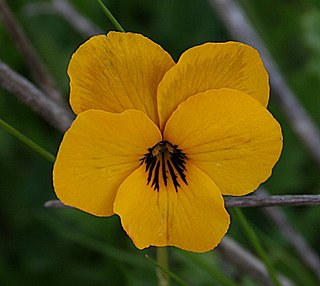
Viola pedunculata, the California golden violet, Johnny jump up, or yellow pansy, is a perennial yellow wildflower of the coast and coastal ranges in California and northwestern Baja California. The common name "Johnny jump up" is usually associated with Viola tricolor however, the introduced garden annual.

Hesperocyparis bakeri, previously known Cupressus bakeri, with the common names Baker cypress, Modoc cypress, or Siskiyou cypress, is a rare species of western cypress tree endemic to a small area across far northern California and extreme southwestern Oregon, in the western United States.

Viola sororia, known commonly as the common blue violet, is a short-stemmed herbaceous perennial plant native to eastern North America. It is known by a number of common names, including common meadow violet, purple violet, woolly blue violet, hooded violet, and wood violet.

Viola sempervirens, known by the common names redwood violet and evergreen violet, is a species in the genus Viola. It is native to the West Coast of the United States and British Columbia, Canada, and grows in closed-cone pine forest, California mixed evergreen forest, redwood forest, and Douglas fir forest communities. It has leathery purple-spotted green leaves and bright yellow flowers. It blooms in winter and spring.

Arctostaphylos bakeri is a species of manzanita known by the common name Baker's manzanita. It is endemic to Sonoma County, California, where it grows in the chaparral and woodlands of the North Coast Ranges. It is sometimes a member of the serpentine soils flora.
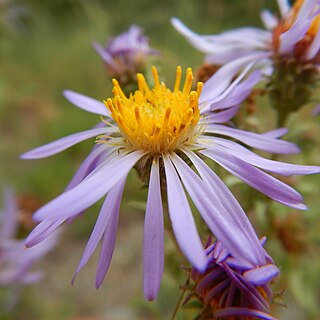
Symphyotrichum campestre is a species of flowering plant of the family Asteraceae commonly known as western meadow aster. It is native to much of western North America where it grows in many habitats, generally at some elevation.
Crepis bakeri is a species of flowering plant in the family Asteraceae known by the common name Baker's hawksbeard. It is native to the western United States where it grows in many types of mountain and plateau habitat. It is found in Oregon, Washington, Idaho, northern California, Nevada, and Utah.
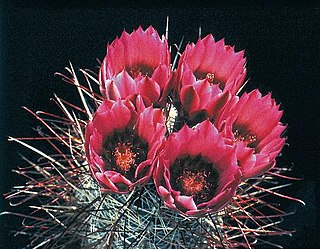
Sclerocactus polyancistrus, the Mohave fishhook cactus or redspined fishhook cactus, is a species of flowering cactus in the genus Sclerocactus. It is found in the Mojave Desert in the Southwestern United States.
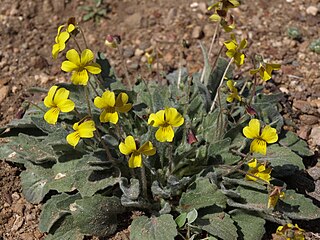
Viola purpurea var. aurea, also known as golden violet and bright yellow violet, is a variety of violet. It is endemic to the western United States, where it is known from scattered occurrences in various types of dry habitat such as the slopes of desert mountains.

Viola cuneata is a species of violet known by the common name wedge-leaf violet. It is native to southwestern Oregon and northwestern California, where it occurs in the forests of the coastal mountain ranges, often on serpentine soils.

Viola douglasii is a species of violet known by the common name Douglas' violet, or Douglas' golden violet. It is native to western North America from Oregon through California and into Baja California, where it grows in seasonally moist habitat, often on serpentine soils. This rhizomatous herb produces a cluster of erect stems just a few centimeters in length to about 20 centimeters in maximum height. The leaf blades are deeply dissected into several narrow lobes or compound, made up of leaflets, and borne on long petioles. They are hairless to softly hairy in texture. A solitary flower is borne on a long, upright stem. It has five bright or deep yellow petals with brown veining and brown outer surfaces. The largest lowest petal may be over 2 centimeters in length.
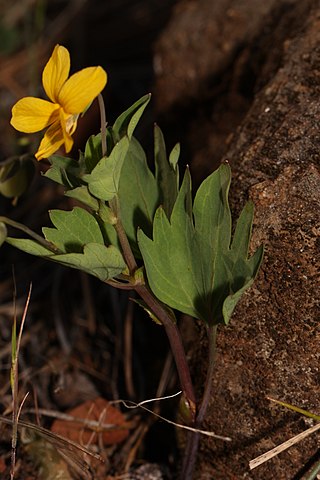
Viola lobata is a species of violet known by the common name pine violet. It is native to western North America from southern Oregon through California and into northern Baja California, where it occurs in mountain ranges and foothills. It grows in woodlands and other habitat. This rhizomatous herb produces an erect stem a few centimeters tall or growing to nearly half a meter in maximum height. The leaves have variously shaped blades borne on long petioles. The blades are 5 to 15 centimeters wide and may be hairless, hairy, or waxy in texture. The leaf blades are often divided into narrow lobes or dissected into small segments. The shape of the leaf blade differentiates the two subspecies; ssp. lobata has dissected leaves and ssp. integrifolia has entire or toothed blades. A solitary flower is borne on a long, upright stem. It has five yellow petals, all five or just the lower three with purple or brown veining and the upper two stained with purple or brown on the outer surfaces.

Viola ocellata is a species of violet known by the common names pinto violet, two-eyed violet, and western heart's ease. It is native to southern Oregon and northern and central California, where it occurs in the coastal foothills and mountain ranges. It sometimes grows in serpentine soils and in quicksilver mines.
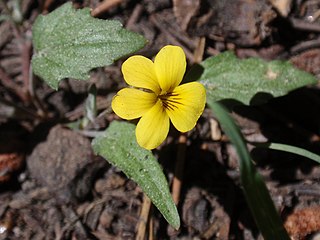
Viola pinetorum is a species of violet known by the common names goosefoot violet, goosefoot yellow violet, gray-leaved violet, or mountain yellow violet. It is endemic to California, where it grows in mountain ranges throughout the state. It occurs in various types of mountain habitat, including forests and talus. This herb grows from a tough taproot and produces an erect or decumbent stem up to about 22 centimeters long. The leaves are linear to oval in shape with pointed tips and toothed edges. The longest ones reach 15 to 20 centimeters in length. A solitary flower is borne on a long, upright stem. It has five yellow petals, the lowest three veined with brownish purple, and the upper two with brownish purple coloring on the outer surfaces.

Viola praemorsa is a species of violet known by the common names canary violet, Astoria violet, yellow montane violet, and upland yellow violet.
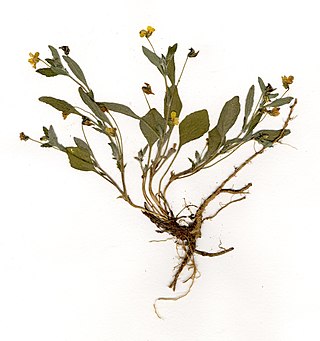
Viola tomentosa is a species of violet known by the common names feltleaf violet and woolly violet. It is endemic to the central Sierra Nevada of California, where it occurs in various types of dry mountain forest habitat. This small herb grows from a deep taproot, reaching a maximum height of 5 to 10 centimeters. The herbage is coated with woolly hairs. The leaves have oval blades borne on petioles a few centimeters long. A solitary flower is borne on a short upright stem. It is under a centimeter long with five yellow petals. The lower three petals are veined with dark brown and the upper two are stained brown or purplish on the back sides.
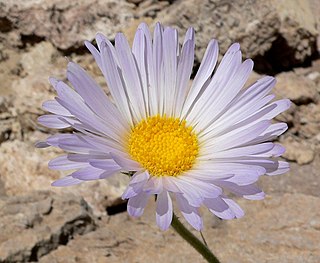
Xylorhiza tortifolia is a species of flowering plant in the family Asteraceae, known by the common names Mojave-aster and Mojave woodyaster.
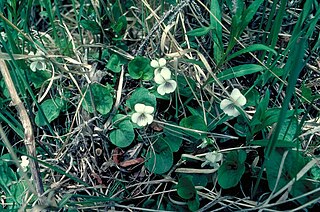
Viola renifolia is a species of violet known by the common names white violet and kidneyleaf violet. It is native to northern North America, where it has a widespread distribution across Canada and the northern United States as far south as Washington, Colorado, and New York.
Coreopsis bakeri, commonly called Baker's tickseed, is a perennial, herbaceous, flowering plant in the Asteraceae family. It is endemic to two counties in northeastern Florida. It is closely related to Coreopsis lanceolata.
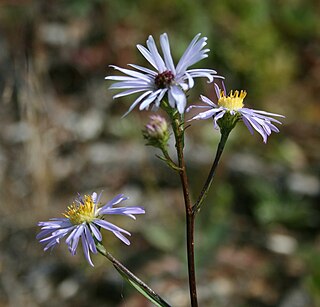
Symphyotrichum foliaceum is a species of flowering plant in the family Asteraceae native to western North America. Its common names are leafy aster, leafy-bracted aster, and alpine leafybract aster, and it is a perennial, herbaceous plant that may reach heights from 10 to 60 centimeters. Its flowers have violet to purple ray florets and yellow disk florets.



















